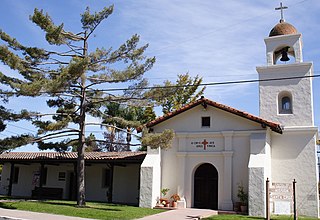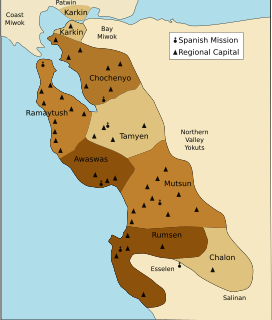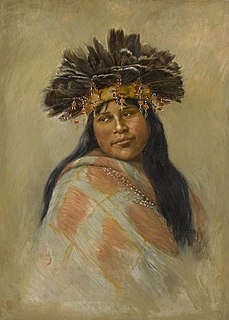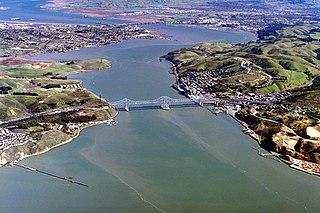
Mission San José is a Spanish mission located in the present-day city of Fremont, California. It was founded on June 11, 1797, by the Franciscan order and was the fourteenth Spanish mission established in California. The mission is the namesake of the Mission San José district of Fremont, which was an independent town subsumed into the city when it was incorporated in 1957. The Mission entered a long period of gradual decline after Mexican secularization act of 1833. After suffering decline, neglect and earthquakes most of the mission was in ruins. Restoration efforts in the intervening periods have reconstructed many of the original structures. The old mission church remains in use as a chapel of Saint Joseph Catholic Church, a parish of the Diocese of Oakland. The museum also features a visitor center, museum, and slide show telling the history of the mission.

The Ohlone, named Costanoan by early Spanish colonists, are a Native American people of the Northern California coast. When Spanish explorers and missionaries arrived in the late 18th century, the Ohlone inhabited the area along the coast from San Francisco Bay through Monterey Bay to the lower Salinas Valley. At that time they spoke a variety of related languages. The Ohlone languages belonged to the Costanoan sub-family of the Utian language family, which itself belongs to the proposed Penutian language phylum.

The Rumsen language is one of eight Ohlone languages, historically spoken by the Rumsen people of Northern California. The Rumsen language was spoken from the Pajaro River to Point Sur, and on the lower courses of the Pajaro, as well as on the Salinas and Carmel Rivers, and the region of the present-day cities of Salinas, Monterey and Carmel.
The Bay Miwok are a cultural and linguistic group of Miwok, a Native American people in Northern California who live in Contra Costa County. They joined the Franciscan mission system during the early nineteenth century, suffered a devastating population decline, and lost their language as they intermarried with other native California ethnic groups and learned the Spanish language.
The Lamchin were one of many tribes of the Ohlone (Coastanoan) people, Native Americans who lived along the San Francisco Peninsula. The Lamchin were the native inhabitants of what is now San Carlos, California. Information is sparse and dispersed, coming mostly from Spanish mission records - as the natives had no written language. The collected information follows over 100 years of research by many noted historians. The Lamchin are believed to be extinct - as historical, statistical and limited written accounts would seem to indicate.
The Ramaytush were one of the linguistic subdivisions of the Ohlone Native Americans of Northern California. Historically, the Ramaytush inhabited the San Francisco Peninsula between San Francisco Bay and the Pacific Ocean in the area which is now San Francisco and San Mateo Counties. The Ramaytush were not thought to be a self-conscious socio-political group. Instead they were defined by modern anthropologists and linguists, initially in the early twentieth century as the San Francisco Costanoans – the people who spoke a common dialect or language within the Costanoan branch of the Utian family. The term Ramaytush was first applied to them during the 1970s.

The Yelamu were a tribelet of Ohlone people from the San Francisco Bay Area in Northern California. The term Yelamu, or "the western people" was used by east bay Ohlone to describe the Ohlone people living on the San Francisco Peninsula. A more correct identification is Ramaytush, according to an account by J.P. Harrington made in 1921 by a Chochenyo Ohlone who identified the peninsula as "ramai". Ramaytush was also the language spoken by them.

The Chalon people are one of eight divisions of the Ohlone (Costanoan) people of Native Americans who lived in Northern California. Chalon is also the name of their spoken language, listed as one of the Ohlone languages of the Utian family. Recent work suggests that Chalon may be transitional between the northern and southern groups of Ohlone languages.

The Awaswas people, also known as Santa Cruz people, are one of eight divisions of the Ohlone Native Americans of Northern California. The Awaswas lived in the Santa Cruz Mountains and along the coast of present-day Santa Cruz County from present-day Davenport to Aptos.

The Tamyen people are one of eight linguistic divisions of the Ohlone (Coastanoan) people groups of Native Americans who lived in Northern California. The Tamyen lived throughout the Santa Clara Valley. The use of the name Tamyen is on record as early as 1777, it comes from the Ohlone name for the location of the first Mission Santa Clara on the Guadalupe River. Father Pena mentioned in a letter to Junipero Serra that the area around the mission was called Thamien by the native people. The missionary fathers erected the mission on January 17, 1777 at the native village of So-co-is-u-ka.
Tammukan is an alternate spelling of Tamcan, the name of a local tribe of Delta Yokuts-speaking natives in the U.S. that once lived on the lower reaches of California's San Joaquin River in what is now eastern Contra Costa County and western San Joaquin County, California. The Tamcans were absorbed into the system of the Spanish missions in California in the early nineteenth century; they moved to Mission San José, near the shore of San Francisco Bay, between 1806 and 1811. At the mission, they and their descendants intermarried with speakers of the San Francisco Bay Ohlone, Plains Miwok, and Patwin Indian languages. Mission Indian survivors of these mixed groups gathered at Alisal, near Pleasanton in Contra Costa County, in the late nineteenth century.

The Ohlone languages, also known as Costanoan, are a small family of languages of the San Francisco Bay Area spoken by the Ohlone people. Along with the Miwok languages, they are members of the Utian language family. The most recent work suggests that Ohlone, Miwok, and Yokuts are branches of a Yok-Utian language family.
The Chalon language is one of eight Ohlone languages, historically spoken by the Chalon people of Native Americans who lived in Northern California. Also called Soledad, it belongs to the one of the Ohlone languages of the Utian family. Recent work suggests that Chalon may be transitional between the northern and southern groups of Ohlone languages.
The Tamyen language is one of eight Ohlone languages, once spoken by Tamyen people in Northern California.
The Ramaytush language is one of the eight Ohlone languages, historically spoken by the Ramaytush people, indigenous people of California. Historically, the Ramaytush inhabited the San Francisco Peninsula between San Francisco Bay and the Pacific Ocean in the area which is now San Francisco and San Mateo Counties. Ramaytush is a dialect or language within the Costanoan branch of the Utian family. The term Ramaytush was first applied to them during the 1970s.

The Rumsen are one of eight groups of the Ohlone, an indigenous people of California.

Awaswas, or Santa Cruz, is one of eight Ohlone languages. It was historically spoken by the Awaswas people, an indigenous people of California.










